NEW ZEALAND
April 6-18,
1999
THE BIG PICTURE
In the spring of 1999, we
traveled through
New Zealand on a group tour arranged through
Elderhostel.
Among the many advantages to an Elderhostel trip are learning opportunities
from usually outstanding lecturers, a great travel value for your money,
and royal treatment.
When our two weeks in New
Zealand were completed, we spent nineteen touring Australia, four days
on a live aboard dive boat on the Great Barrier Reef off the coast of
Queensland and four days in Fiji on the way home. Those portions of the
trip are covered in separate sections.
Our New Zealand portion
of the trip began in Auckland on the
North Island, a bus ride to Rotorua,
a flight to Queenstown on the South
Island, a bus ride to Te Anau and
Milford Sound,
and eventually to Invercargill
and a flight to Christchurch,
our last stop in New Zealand.
THE FLIGHT
Let's be honest: It's a
long way from Los Angeles to Auckland, New Zealand. We left at 9:30 in
the evening and landed in Auckland, New Zealand's largest city (but not
the capital) at 5:30 in the morning. Somewhere along the way we lost a
day and passed through five time zones. The huge Qantas 757 was about half
full so we were able to find 4-5 empty seats next to each other that we
could stretch out on and sleep. We arrived feeling rather rested and ready
to go.
AUCKLAND
A quarter of the country's population lives in Auckland,
yet the city remains very manageable, beautifully
 positioned on 46 dormant volcanos on one of the most beautiful harbors in the world.
We're told there are more boats/ships per capita than anywhere in the world.
Public transportation is efficient and goes almost everywhere. Downtown
shopping was great fun, full of bargains--especially with the exchange
rate of NZ$1.00 = US$0.65--at both large stores and small shops.
positioned on 46 dormant volcanos on one of the most beautiful harbors in the world.
We're told there are more boats/ships per capita than anywhere in the world.
Public transportation is efficient and goes almost everywhere. Downtown
shopping was great fun, full of bargains--especially with the exchange
rate of NZ$1.00 = US$0.65--at both large stores and small shops.
As it seems in most English
settled countries, the parks are beautiful and great for
runners, especially
Albert Park in the center of the city, and
Auckland Domain. The Maritime Museum
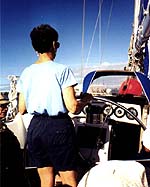 near the site of the yacht harbor where the America's Cup is being held was
worth the visit. (Yes, that's Judy at the helm of the "Pride of Auckland"
in Auckland Harbour.) Don't miss the moa in the Auckland National Museum: it's
at least 10' tall! Be sure to take the ten minute boat ride across the harbor to
Devonport and poke around in this charming
suburb of real houses, real people, and real businesses reminiscent of an English
village. All in all, this is terrific city!
near the site of the yacht harbor where the America's Cup is being held was
worth the visit. (Yes, that's Judy at the helm of the "Pride of Auckland"
in Auckland Harbour.) Don't miss the moa in the Auckland National Museum: it's
at least 10' tall! Be sure to take the ten minute boat ride across the harbor to
Devonport and poke around in this charming
suburb of real houses, real people, and real businesses reminiscent of an English
village. All in all, this is terrific city!
Lectures presented by Auckland
University professors on NZ history and economics;
Maori language,
history, and culture; and the NZ political system were quite good, especially on
Maori--English relations since the invasion by the British in the 1800s. Though
certainly not perfect, the treatment of the Maoris by the English has been much more
positive and progressive than similar relations in the US and Australia.
NZ, our lecturers suggested, is a newer country and, having observed the
(moral) mistakes that had taken place in the other two countries, tried
"to get it right." Our sense is NZ has been more successful from the start
and are continuing to be progressive.
ROTORUA
Three hours south of Auckland,
Rotorua
is a beautifully situated lakeside town in the heart of volcanic activity.
Its emphasis on Maori culture makes it the North Island's most popular
tourist destination, and for good reason.
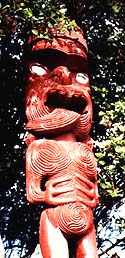 The Maori proudly display their art, their music, their carving, their food,
their history--all of which we found exotic and fascinating. Don't miss
the Maori Arts and Crafts Institute.
In addition, the area is infested with geysers, fumaroles, mud pools, steam vents,
and the smell of sulfur; it's like a miniature, compact Yellowstone.
The Maori proudly display their art, their music, their carving, their food,
their history--all of which we found exotic and fascinating. Don't miss
the Maori Arts and Crafts Institute.
In addition, the area is infested with geysers, fumaroles, mud pools, steam vents,
and the smell of sulfur; it's like a miniature, compact Yellowstone.
We pakehas (non-Maoris)
were treated to a traditional hangi (feast) at the wharekai
(dining house) at
Te Tawa Ngahere Pa, a reconstructed Maori village. It was an evening's
entertainment not unlike what you would experience at Bunratty Castle in
Ireland, a fiesta in Puerto Vallarta, or a lua'u in Kona. Traditional food,
dances, music, traditional challenges to
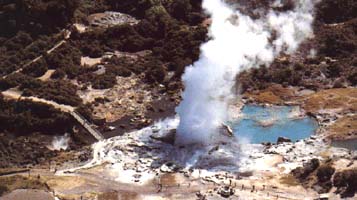 visitors (complete with bulging eyes and threatening long tongues) followed
by short welcoming speeches and hongis all around (pressing noses
in greeting--two times and never hard). Something for the tourists to be
sure, but instructive and entertaining, and worth the price of admission.
visitors (complete with bulging eyes and threatening long tongues) followed
by short welcoming speeches and hongis all around (pressing noses
in greeting--two times and never hard). Something for the tourists to be
sure, but instructive and entertaining, and worth the price of admission.
Rotorua is also a great
place to shop, especially for jade. Jade (greenstone) and bone carving
have always been greatly prized by Maoris and some of the finest carvers
have their studios in Rotorua. We met and talked with several artists,
and Judy bought some beautiful pieces for herself and for gifts.
QUEENSTOWN
Old mining towns make us feel right at home.
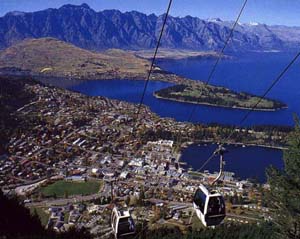 Though its origins are in the gold rush of the 1860s, today adventure tourism
drives Queenstown (population
about 14,000). It is the South Island's headquarters for outdoor activities
of all kinds: skiing, trekking, and fishing; the first
bungy jumping
operation began just outside of town. Sheep stations are huge
and numerous and there is a growing wine industry in the area (look for
an outstanding Pinot Gris from Gibbston
Valley Winery). The town is beautifully located on Lake Wakatipu surrounded
by
Though its origins are in the gold rush of the 1860s, today adventure tourism
drives Queenstown (population
about 14,000). It is the South Island's headquarters for outdoor activities
of all kinds: skiing, trekking, and fishing; the first
bungy jumping
operation began just outside of town. Sheep stations are huge
and numerous and there is a growing wine industry in the area (look for
an outstanding Pinot Gris from Gibbston
Valley Winery). The town is beautifully located on Lake Wakatipu surrounded
by  angular mountains; it was easy to feel at home here. The town has a pedestrian
mall filled with shops, a fine restaurant accessible by a 1,450' gondola
ride to an outstanding restaurant overlooking the town and lake, several
internet coffee houses, a running path of several miles along the lake
shore, and golf courses. We'd go back in a second.
angular mountains; it was easy to feel at home here. The town has a pedestrian
mall filled with shops, a fine restaurant accessible by a 1,450' gondola
ride to an outstanding restaurant overlooking the town and lake, several
internet coffee houses, a running path of several miles along the lake
shore, and golf courses. We'd go back in a second.
We were able to get in a
white water rafting trip on the Kawarau River
(class III-IV). It was only a half day trip, but got our adrenaline moving.
Arrowtown,
is a well maintained a "ghost town" from the gold rush days just a few miles away.
TE ANAU
and
MILFORD SOUND
It would be impossible to take a bad photograph of the small town of
Te Anau.
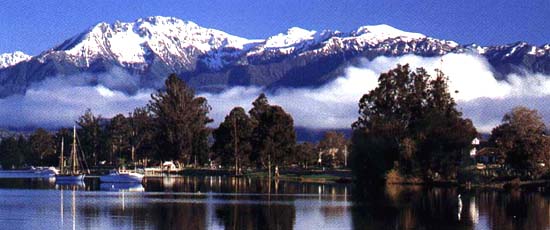 It sits on placid, mirror Lake Te Anau across from spectacular mountains that
rise up to the west. It is also the gateway town for the
Milford Track,
one of the world's best known hiking trails or "treks:" 33 miles and four days
from the north end of Lake Te Anua to Milford Sound on an inlet of the Tasman
Sea. Trekkers preparing to hike the area of course read
Moir's Guide South (Great Southern Lakes Press, Christchurch, 1995:
6th edition edited by Robin McNeill).
It sits on placid, mirror Lake Te Anau across from spectacular mountains that
rise up to the west. It is also the gateway town for the
Milford Track,
one of the world's best known hiking trails or "treks:" 33 miles and four days
from the north end of Lake Te Anua to Milford Sound on an inlet of the Tasman
Sea. Trekkers preparing to hike the area of course read
Moir's Guide South (Great Southern Lakes Press, Christchurch, 1995:
6th edition edited by Robin McNeill).
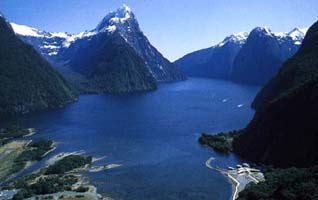
The Milford Road (completed in 1953) is a 74-mile
engineering feat rivaling many roads in the Rockies. Passing by Mount Moir near
the Homer Tunnel at the top of the pass, we reached the eastern end of
Milford Sound (really a fiord, shown on
the right) in time to hop on a boat that took us out to the Tasman Sea, passing
sea lions and scores of waterfalls.
INVERCARGILL
and
CHRISTCHURCH
Invercargill
is an undistinguished town at the southern tip of NZ. We were lucky to
be in town when the first crop of
Bluff oysters,
from the fishing village of Bluff.
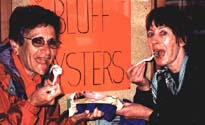 The oysters are only available for a short time each year. Judy, who had eaten
oysters everywhere on the trip, said they were outstanding.
The oysters are only available for a short time each year. Judy, who had eaten
oysters everywhere on the trip, said they were outstanding.
We flew to
Christchurch,
the South Island's largest city (population about 350,000), a city founded
in the 1850s by John Godley and the Canterbury Foundation as an Anglican
stronghold in the Southern Hemisphere. Their aim was to create a city "more
British than Britain." They brought their cricket bats and rowing shells,
built lawn tennis courts, erected their church(es), planted public gardens
with local trees and plants as well as imports from Britain, and uniformed
Christ College schoolboys glided their punts down the Avon River which
runs through city center. By 1853, 3,500 very carefully screened Anglicans
were the sole residents of Christchurch. However, a drought in Australia
brought too many Aussie sheep ranchers to the area to be denied
citizenship. Later, of course, Maoris and other people
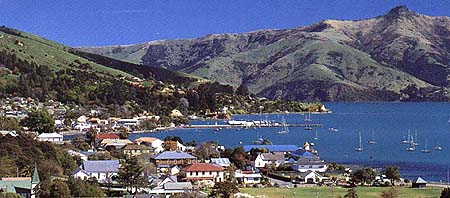 of color and ethnicity have been welcomed. The city has grown well beyond
the narrow views of John Godley, yet is the most English city we encountered.
of color and ethnicity have been welcomed. The city has grown well beyond
the narrow views of John Godley, yet is the most English city we encountered.
An hour or so away is
Akaroa,
a very picturesque former French settlement south and east of Christchurch
on the Banks Peninsula. In addition
to art galleries and quaint shoppes for browsing, it will be remembered
 (by us) for the "Elderly Crossing" warning sign in the center of town.
(by us) for the "Elderly Crossing" warning sign in the center of town.
Near the Christchurch airport
is the Antarctic
Centre, a demonstration center and museum devoted to south polar
exploration. Don't miss it! It is a remarkable place to learned more about
Antarctica than we'd thought possible. It was the last stop in New Zealand
before taking the plane to Melbourne.
Some Miscellaneous Recollections
We came to really like
New Zealanders. We were always impressed with the quality of the New
Zealand people we met. Soft spoken, somewhat formal, modest, hardworking,
proud of their country, and welcoming of strangers. We didn't meet one
we would not choose for a neighbor.
The cities are clean,
and seem to be a source of pride by those we met who lived there. That
there are areas of physical decay and social strife, we have no doubt.
We looked everywhere we could for the settings for Alan Duff's tough and
provocative novels dealing with the plight of urban Maoris
(Once Were Warriors
[also a fine movie] or
Both Sides of the Moon),
but didn't see any areas that came close, though they must exist.
"Possums? Squash 'em." You hear it everywhere. New Zealanders literally
go out of their way to run over opossums on roads and highways. They're another
pest from Australia that do great harm to farms animals and crops. There's
no bounty offered, only a matter of doing your part for your country. It's
not like Texans who run over armadillos for kicks.
A Plug for Elderhostel
In addition to very comfortable,
occasionally spectacular hotel accommodations, NZ hotel restaurants consider
their guests visiting royalty. Dinner buffets always included carved beef
roast, pork loin, and succulent lamb (never mutton). Venison, a growing
industry in New Zealand (exported largely to Germany) was often available.
For seafood lovers, there was always an abundance of oysters, clams, muscles,
 various local freshwater and ocean fish, and shrimp to eat--sometimes crab
and lobster. Outstanding quality and enough food to feed a small nation--and
then there were the desserts....
various local freshwater and ocean fish, and shrimp to eat--sometimes crab
and lobster. Outstanding quality and enough food to feed a small nation--and
then there were the desserts....
Judy likes group travel,
at least with Elderhostel. They
relieve us of the burden and concern for making decisions and put it in
the hands of experienced, knowledgeable individuals whose responsibility
is for our travel comfort, enlightenment, and pleasure. Elderhostel travelers
are usually experienced and rarely complain or are embarrassingly demanding.
Hughes agrees, though suggests there can be drawbacks: we have to keep
to a schedule not of our making, and we do not always have the time we'd
like to take in everything that's available (though Elderhostel trips are
flexible: we did skip the winery tour and went white water rafting on our
own). However, the trade-off is usually worth it. We both were able to
relax and enjoy thoroughly everything on the trip. We are sold on Elderhostel
as the very best travel value we know of. We have two more planned for
this year, and we'll likely plan at least one a year indefinitely.
Last updated: March 31, 2000
 positioned on 46 dormant volcanos on one of the most beautiful harbors in the world.
We're told there are more boats/ships per capita than anywhere in the world.
Public transportation is efficient and goes almost everywhere. Downtown
shopping was great fun, full of bargains--especially with the exchange
rate of NZ$1.00 = US$0.65--at both large stores and small shops.
positioned on 46 dormant volcanos on one of the most beautiful harbors in the world.
We're told there are more boats/ships per capita than anywhere in the world.
Public transportation is efficient and goes almost everywhere. Downtown
shopping was great fun, full of bargains--especially with the exchange
rate of NZ$1.00 = US$0.65--at both large stores and small shops.
 near the site of the yacht harbor where the America's Cup is being held was
worth the visit. (Yes, that's Judy at the helm of the "Pride of Auckland"
in Auckland Harbour.) Don't miss the moa in the Auckland National Museum: it's
at least 10' tall! Be sure to take the ten minute boat ride across the harbor to
Devonport and poke around in this charming
suburb of real houses, real people, and real businesses reminiscent of an English
village. All in all, this is terrific city!
near the site of the yacht harbor where the America's Cup is being held was
worth the visit. (Yes, that's Judy at the helm of the "Pride of Auckland"
in Auckland Harbour.) Don't miss the moa in the Auckland National Museum: it's
at least 10' tall! Be sure to take the ten minute boat ride across the harbor to
Devonport and poke around in this charming
suburb of real houses, real people, and real businesses reminiscent of an English
village. All in all, this is terrific city!
 The Maori proudly display their art, their music, their carving, their food,
their history--all of which we found exotic and fascinating. Don't miss
the Maori
The Maori proudly display their art, their music, their carving, their food,
their history--all of which we found exotic and fascinating. Don't miss
the Maori  visitors (complete with bulging eyes and threatening long tongues) followed
by short welcoming speeches and hongis all around (pressing noses
in greeting--two times and never hard). Something for the tourists to be
sure, but instructive and entertaining, and worth the price of admission.
visitors (complete with bulging eyes and threatening long tongues) followed
by short welcoming speeches and hongis all around (pressing noses
in greeting--two times and never hard). Something for the tourists to be
sure, but instructive and entertaining, and worth the price of admission.
 Though its origins are in the gold rush of the 1860s, today adventure tourism
drives
Though its origins are in the gold rush of the 1860s, today adventure tourism
drives  angular mountains; it was easy to feel at home here. The town has a pedestrian
mall filled with shops, a fine restaurant accessible by a 1,450' gondola
ride to an outstanding restaurant overlooking the town and lake, several
internet coffee houses, a running path of several miles along the lake
shore, and golf courses. We'd go back in a second.
angular mountains; it was easy to feel at home here. The town has a pedestrian
mall filled with shops, a fine restaurant accessible by a 1,450' gondola
ride to an outstanding restaurant overlooking the town and lake, several
internet coffee houses, a running path of several miles along the lake
shore, and golf courses. We'd go back in a second.
 It sits on placid, mirror Lake Te Anau across from spectacular mountains that
rise up to the west. It is also the gateway town for the
It sits on placid, mirror Lake Te Anau across from spectacular mountains that
rise up to the west. It is also the gateway town for the

 The oysters are only available for a short time each year. Judy, who had eaten
oysters everywhere on the trip, said they were outstanding.
The oysters are only available for a short time each year. Judy, who had eaten
oysters everywhere on the trip, said they were outstanding.
 of color and ethnicity have been welcomed. The city has grown well beyond
the narrow views of John Godley, yet is the most English city we encountered.
of color and ethnicity have been welcomed. The city has grown well beyond
the narrow views of John Godley, yet is the most English city we encountered.
 (by us) for the "Elderly Crossing" warning sign in the center of town.
(by us) for the "Elderly Crossing" warning sign in the center of town.
 various local freshwater and ocean fish, and shrimp to eat--sometimes crab
and lobster. Outstanding quality and enough food to feed a small nation--and
then there were the desserts....
various local freshwater and ocean fish, and shrimp to eat--sometimes crab
and lobster. Outstanding quality and enough food to feed a small nation--and
then there were the desserts....
